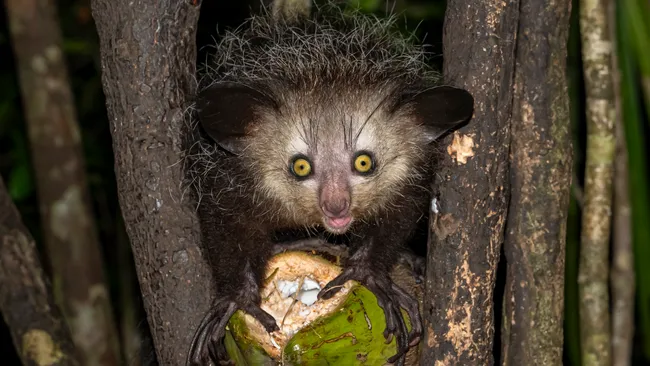Aye-ayes are remarkable thanks to their extra-long, bony middle fingers, which they use to locate grubs and pick their noses.
A Curious Creature of the Night: The Aye-Aye
Native to Madagascar, the aye-aye is one of the most unusual primates on Earth. With owl-like eyes, bat-shaped ears, teeth that never stop growing, and a fluffy tail longer than its body, the aye-aye looks like it was assembled from spare parts of other animals.
Weighing about 4 pounds (1.8 kg) and measuring up to 24 inches (60 cm) from nose to tail tip, the aye-aye holds the title of the world’s largest nocturnal lemur. Juveniles sport silvery fur with a stripe down the back, but as they mature, this transitions into a shaggy yellow-brown coat tipped in white. These lemurs snooze during the day in leafy nests high in the trees and spend the night foraging in the forest canopy.
One of their most bizarre features is a long, skeletal middle finger — more than just creepy-looking, it’s a vital foraging tool. As they climb along branches, aye-ayes tap on wood with this finger and listen for hollow sounds that hint at the presence of insect larvae. Once prey is found, the lemur uses its rodent-like teeth to gnaw a hole into the bark, then slides in that spindly finger to extract the grub. Thanks to a ball-and-socket joint at the base, this digit has a wide range of motion, perfect for probing into tight spaces.
But this finger has another, more peculiar use: deep nose-picking. A 2022 study published in the Journal of Zoology observed aye-ayes inserting their long fingers deep into their nasal passages — sometimes reaching all the way to the back of the throat — and then licking off the mucus. Researchers speculate they may be drawn to the salty, crunchy texture, which could also help clean their constantly growing teeth.
Speaking of teeth, the aye-aye’s incisors — like those of rodents — grow continuously throughout its life. These are kept in check by the tough work of chewing through wood and nutshells.
Despite their unique adaptations, aye-ayes are often misunderstood. In Malagasy folklore, they’re seen as omens of death. Some believe that if an aye-aye points its long finger at a person, it signals doom — a superstition that has led to the needless killing of these animals. Though once thought extinct, they were rediscovered in the 1950s, but their numbers remain dangerously low, and they’re currently listed as endangered.
To survive in the wild, aye-ayes rely on stealth and camouflage. Their dark fur helps them blend into the forest shadows, while their keen hearing detects even the softest rustle — an essential skill when avoiding predators like the fossa, Madagascar’s top carnivorous mammal. If threatened, they may freeze in place to avoid being seen or dash swiftly through the treetops to safety.
With their mix of mystery, myth, and marvel, aye-ayes are truly one of nature’s strangest — and most fascinating — creatures.
